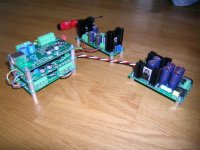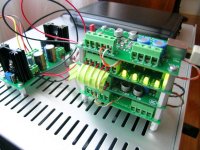The major design point however, is that it can output I2S direct to the DAC without using SPDIF.
Why is this so important? My understanding of why everyone hates S/PDIF so much is because of jitter introduced by poor clocks. So, it would see to me anyway, if you have a soundcard with S/PDIF output you are really comparing the clock included with the USB interface with the one included with your soundcard. I have sort of a cursory understanding of a lot of these topics so I'm looking for an opportunity to learn. Someone please correct me if my statements are inaccurate.
m0tion, you questions are perfectly good ones, and I am afraid I cannot answer them all(yet). 🙂
I2S generally has much less jitter than SPDIF.
What you should remember is that the single USB module you are talking about may not be in the scope of what you want. But I have good news! Opus very likely still supports exactly what you want to do. 🙂 You could easily take the clock and SPDIF from you sound card and use it as input to the DAC using one of the two SPDIF modules. OR, you could easily design our own SPDIF module and feed the I2S(or whatever) to the DAC module.
Cheers!
Russ
I2S generally has much less jitter than SPDIF.
What you should remember is that the single USB module you are talking about may not be in the scope of what you want. But I have good news! Opus very likely still supports exactly what you want to do. 🙂 You could easily take the clock and SPDIF from you sound card and use it as input to the DAC using one of the two SPDIF modules. OR, you could easily design our own SPDIF module and feed the I2S(or whatever) to the DAC module.
Cheers!
Russ
What is the dimension of the dual supply board? Is it also driven off the toroid? Would the one toroid be sufficient to run a dual and LCPS?
Since the LCPS has vreg, could I run it off my 25+25 40VA toroid?
Since the LCPS has vreg, could I run it off my 25+25 40VA toroid?
They are both regulated, so yes, you could.
You could not run both supplies off a single trafo, however, as the LCPS is two seperate supplies, and the Dual supply will connect two of your secondaries as a 0V (GND).
You could not run both supplies off a single trafo, however, as the LCPS is two seperate supplies, and the Dual supply will connect two of your secondaries as a 0V (GND).
BrianDonegan said:Dac/USB/Ballsie stack, along with LCPS and new Dual supply for Ballsie.
That looks far to tempting to ignore.
So any comparisons between USB and spdif coming?

It would be good to know if the pcm-2707 module works as well as the rest of the dac or if it lets the team down... (especially as its usb powered)
MegaMe said:It would be good to know if the pcm-2707 module works as well as the rest of the dac or if it lets the team down... (especially as its usb powered)
When used as intended (just I2S out) the fact that it is bus powered should make no difference at all.
Cheers!
Russ
esting USB (S/PDIF Out) -> WM8804 Receiver -> DAC -> Ballsie (not connected)...
This setup was really just to test the USB S/PDIF out mode. If used in this config, I would use the USB I2S out => Receiver I2S In (dejitter) => DAC (I2S)
[EDIT] Actually, not sure if it's possible to do this (I2S in and out at the same time). Will test it tonight.
Another newbie question here...
Just to be sure, If I intend to get the Opus and the Ballsie I will need two trafos?
And there will be any problem running the LCPS/Dual with the Avel trafo and 220V?
Just to be sure, If I intend to get the Opus and the Ballsie I will need two trafos?
And there will be any problem running the LCPS/Dual with the Avel trafo and 220V?
I recently put a Zapfilter into the Opus and have a slight hum problem. I'm running two opus dac boards in dual differential mode. The output from the zapfilter goes to a set of XLR's as well as RCA's.
I'm getting the hum through the RCA's. If I disconnect the - signals between the DAC and the zapfilter, the hum completely vanishes. Can anyone think of an idea for this?
-edit- volume also decreases a good deal through the RCA's when I pull out the - signal from the DAC. Could this just be that the DAC chips are straining since they're not seeing a load on those outputs?
I'm getting the hum through the RCA's. If I disconnect the - signals between the DAC and the zapfilter, the hum completely vanishes. Can anyone think of an idea for this?
-edit- volume also decreases a good deal through the RCA's when I pull out the - signal from the DAC. Could this just be that the DAC chips are straining since they're not seeing a load on those outputs?
SoapSeller said:Another newbie question here...
Just to be sure, If I intend to get the Opus and the Ballsie I will need two trafos?
And there will be any problem running the LCPS/Dual with the Avel trafo and 220V?
technically speaking, you could use just one dual trafo, but I would suggest you use two.
To use just one you would use one secondary for VA/VD/V+ and the other for V-.
It would work, but it is not optimal.
fierce_freak said:II'm getting the hum through the RCA's. If I disconnect the - signals between the DAC and the zapfilter, the hum completely vanishes. Can anyone think of an idea for this?
There must be a GND loop between the Opus and ZF. But I have no idea where to start looking.
fierce_freak said:-edit- volume also decreases a good deal through the RCA's when I pull out the - signal from the DAC. Could this just be that the DAC chips are straining since they're not seeing a load on those outputs?
that is happening because the ZF is only seeing half the swing.
Thanks, Russ. My first thought was ground loop, but I wasn't sure what could be causing it. I'll have to investigate it more thoroughly once I get home.
I looked up Zapfilter and I don't understand why you need an "analog" stage on the output of this DAC. I mean, stupid question time, isn't the output of the DAC already analog? =)
Yeah, that was my next thought (but of course, i'm here at work). It's just really odd that removing the connection between the DAC boards and the Zapfilter for the negative phase signals cleared up the hum.
m0tion: You don't need an extra output stage to use the DAC, but adding something like the zapfilter helps to filter and buffer the signal.
m0tion: You don't need an extra output stage to use the DAC, but adding something like the zapfilter helps to filter and buffer the signal.
fierce_freak said:m0tion: You don't need an extra output stage to use the DAC, but adding something like the zapfilter helps to filter and buffer the signal.
"Ballsie" may be better suited to the task, and gets you both SE and BAL buffered outputs.
But honestly since its a voltage output DAC nothing more is necessary for loads down to 1K.
- Home
- More Vendors...
- Twisted Pear
- Mr White's "Opus", designing a simple balanced DAC

